
The Ogle County Courthouse is a National Register of Historic Places listing in the Ogle County, Illinois, county seat of Oregon. The building stands on a public square in the city's downtown commercial district. The current structure was completed in 1891 and was preceded by two other buildings, one of which was destroyed by a group of outlaws. Following the destruction of the courthouse, the county was without a judicial building for a period during the 1840s. The Ogle County Courthouse was designed by Chicago architect George O. Garnsey in the Romanesque Revival style of architecture. The ridged roof is dominated by its wooden cupola which stands out at a distance.

The Washington County Courthouse in Hillsboro, Oregon is the courthouse for Washington County, Oregon, in the United States. Washington County was established in 1843 and the first government building was finished in 1852. The current courthouse was built in 1928 with an addition and renovations to the structure in 1972. Currently the building houses courtrooms, the county sheriff's dispatch, staff offices, and the office of the district attorney. The county jail was previously attached to the courthouse.
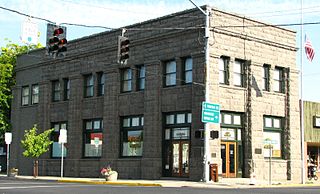
The A. R. Bowman Memorial Museum is a local history museum in Prineville, Oregon, United States. Opened in 1971, the museum is housed in the old Crook County Bank Building which is listed on the National Register of Historic Places. The museum is run by the Crook County Historical Society and highlights the history of Crook County and central Oregon. Its collection includes many original pioneer artifacts, a large railroad exhibit, ranching and timber industry displays, furniture, garments, and historic photographs. The museum also has a research library.

The Crook County Bank is a historic bank building in Prineville, Oregon, United States. It was built in 1910 using stone blocks from a local quarry. The building was first use as a bank and then occupied by title and insurance business until 1971, when ownership was transferred to Crook County for use as a local history museum. Today, the Crook County Bank building is the home of the A. R. Bowman Memorial Museum. Because of its importance to the history of Prineville, the Crook County Bank Building is listed on the National Register of Historic Places.

The O'Kane Building is a historic commercial building in Bend, Oregon, United States. The structure was built in 1916 by Hugh O'Kane, a local businessman. The two-story building is located downtown on the west corner of Oregon Avenue and Bond Street.

The N. P. Smith Pioneer Hardware Store is a historic commercial building in Bend, Oregon, United States. The structure was built in 1909 by Nichols P. Smith, a Bend businessman. The two-story building originally housed a hardware business on the ground floor with family quarters on the second floor. The building is located on the Northwest Wall Street in downtown Bend. It has been in continuous use as a commercial building since it first opened. Today, the Smith Hardware Store is the only wood-frame structure that remains in downtown Bend. Because of its importance to the history of Bend, the Smith Pioneer Hardware Store is listed on the National Register of Historic Places.
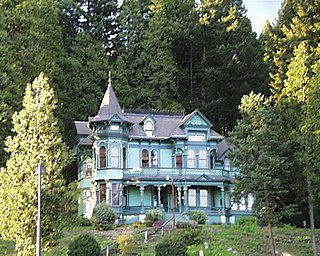
Walter David Pugh was an American architect based in Salem, Oregon, United States.

The Jasper County Courthouse is located in Newton, Iowa, United States, and was built from 1909 to 1911. It was individually listed on the National Register of Historic Places in 1981. In 2014 it was included as a contributing property in the Newton Downtown Historic District.

The Scott County Courthouse in Davenport, Iowa, United States was built from 1955 to 1956 and extensively renovated over a ten-year period between 1998 and 2009. It is the third building the county has used for court functions and county administration. It is part of a larger county complex that includes the county jail, administration building and juvenile detention facility. In 2020 the courthouse was included as a contributing property in the Davenport Downtown Commercial Historic District on the National Register of Historic Places.

The Greene County Courthouse, located in Jefferson, Iowa, United States, was built in 1918. It was individually listed on the National Register of Historic Places in 1978 as a part of the County Courthouses in Iowa Thematic Resource. In 2011, it was included as a contributing property in the Jefferson Square Commercial Historic District. The courthouse is the third structure to house court functions and county administration. The courthouse features the Mahany Tower, a 120 feet bell tower.
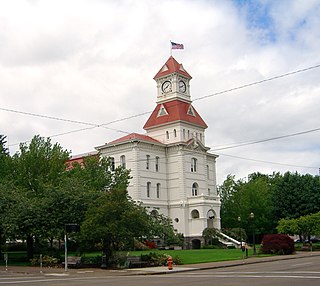
The Benton County Courthouse is a courthouse building located in Corvallis, Benton County, in the U.S. state of Oregon. Built in 1888, the facility is regarded as the oldest county courthouse in Oregon still being used for its original purpose. It is listed on the National Register of Historic Places.
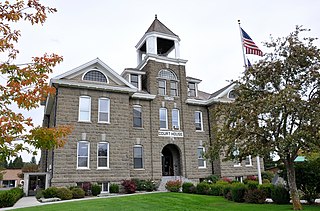
The Wallowa County Courthouse is the seat of government for Wallowa County in northeastern Oregon. The courthouse is located in Enterprise, Oregon. It was built in 1909–1910 using locally quarried stone. It is a massive High Victorian structure built of local Bowlby stone. The courthouse was listed on National Register of Historic Places in 2000. Today, the courthouse still houses Wallowa County government offices.

The Garfield County Courthouse, at 8th and Main streets in Pomeroy, Washington, was built in 1901. It is of Late Victorian architecture, designed by Charles Burggraf and built by Spokane contractor August Isle. It was identified as "one of several elaborate county courthouses constructed in Washington around the turn of the century" when it was listed on the National Register of Historic Places in 1974.
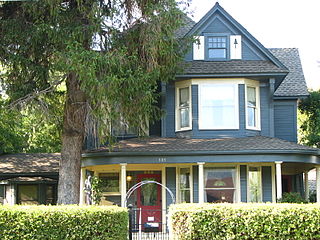
The Marion Reed Elliott House is a historic house in Prineville, Oregon, United States. Built in 1908, it is the largest and best-preserved Queen Anne style house in Prineville. It is also significant as one of a handful of surviving structures that were built by prominent local contractor Jack Shipp (1858–1942). Marion Elliott (1859–1934), an educator and successful attorney, lived in the house from its construction until his death. Both men's careers benefited from the economic boom that occurred in Prineville in the first decades after railroads began reaching Central Oregon around 1900, the period when the Elliott House was built.

The Old First National Bank of Prineville is a historic commercial building in Prineville, Oregon, United States.

Boyd Richey Overhulse was an American politician and attorney from Oregon. He served three terms in the Oregon House of Representatives followed by two terms in the Oregon State Senate. A conservative Democrat from a rural district, Overhulse was known for his ability to work with Republicans as well as fellow Democrats in the state legislature. He was elected President of the Oregon Senate eleven days after taking his seat in the state senate, the first Democrat elected to that position in 79 years.

Harley James Overturf was an American politician and businessman from the state of Oregon. He was a Republican who served four years in the Oregon House of Representatives, where he represented a large rural district in eastern Oregon. Overturf Butte in Bend, Oregon, is named in his honor.

Horace Preston Belknap was an American pioneer medical doctor, businessman, and a state legislator from the state of Oregon. Belknap was one of the first physicians to establish a medical practice in Central Oregon. He also served three terms in the Oregon House of Representatives as a Republican legislator, representing a large and rural district in central and southern Oregon.
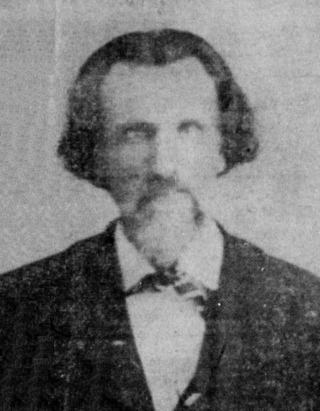
Francis Barnett Prine was an American pioneer who was one of the first settlers to homestead in the Ochoco country of central Oregon. When he was young, Prine traveled with his family from Missouri to Oregon's Willamette Valley over the Oregon Trail. He served in the 1st Oregon Volunteer Infantry Regiment during the American Civil War. Prine later moved to the Central Oregon, where he established several businesses in what became Prineville, Oregon, a town named in his honor.

Cass Adelbert Cline was an American pioneer who was an early settler in central Oregon. Cline’s family moved to Oregon when he was a small child, settling west of the Cascade Mountains near Roseburg. As a young man, Cline moved to central Oregon and claimed homestead land along the Deschutes River. He later became a well-known dentist, property developer, and race horse breeder. Today, a waterfall on the Deschutes River, a nearby mountain group, and a state park bear his name.




















